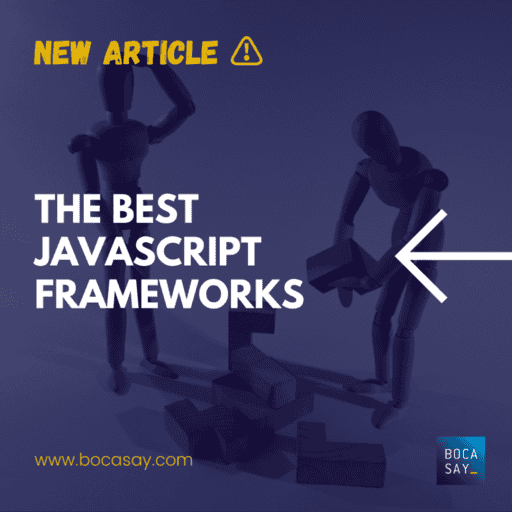The Best JavaScript Frameworks
JavaScript is one of the most popular programming languages in the world. It is widely used for building websites, apps and games. It is also the programming language behind many of the world’s most popular websites.
Javascript is a programming language that is particularly well-suited to developing interactive web pages. It was created by Brendan Eich in 1995 and first appeared in Netscape Navigator 2.0. It is also known as ECMAScript or ECMA-262 and it is a prototype-based scripting language.
In this article, Bocasay, our offshore outsourcing company, provides an overview of the most popular JavaScript frameworks currently used in web development across a wide range of markets and industries.

What are JavaScript Frameworks?
JavaScript frameworks are pre-written, reusable code libraries that provide developers with a set of pre-built functions, modules and components to simplify and speed up the development of complex JavaScript applications. These frameworks provide a standardized set of tools and features for building interactive web applications, single-page applications (SPAs) and mobile applications. JavaScript frameworks help developers by providing a structure, organization and a set of best practices to follow.
Top JavaScript Frameworks
Angular.JS
Developed in 2009 by Google, AngularJS is an open-source framework for building web applications in HTML and Javascript. It uses MVC (Model View Controller) architecture which divides an app into three components: model, view, and controller. Each plays a specific role in communicating with each other to produce results that users can see on their screen as they interact with their computers or mobile devices. The best thing about AngularJS is that it makes coding easier by taking care of repetitive tasks such as creating HTML templates from scratch every time you want to build a new page, or creating multiple objects from scratch every time you want them included.
React.JS
Created in 2013, React.JS is a JavaScript library for building user interfaces. It uses JSX, which is a syntax extension to HTML, that makes it easier to create declarative UI components.
By providing stateless functional reactive programming (FRP) APIs, developers can easily handle event-based interactions in their applications. Its small and modular design encourages creativity and enables developers to build large, featureful UIs with fewer lines of code than other libraries like Angular or Vue2+.
Finally, because React.JS doesn’t require any dependencies on external libraries like jQuery or Lodash, web app development can be much simpler and faster than frameworks which depend on those utilities.
𝔻𝕠 𝕪𝕠𝕦 𝕟𝕖𝕖𝕕 𝕒 𝕡𝕒𝕣𝕥𝕟𝕖𝕣 𝕔𝕒𝕡𝕒𝕓𝕝𝕖 𝕠𝕗 𝕡𝕣𝕠𝕕𝕦𝕔𝕚𝕟𝕘 𝕙𝕚𝕘𝕙 𝕢𝕦𝕒𝕝𝕚𝕥𝕪 𝕀𝕋 𝕕𝕖𝕧𝕖𝕝𝕠𝕡𝕞𝕖𝕟𝕥 𝕗𝕠𝕣 𝕪𝕠𝕦𝕣 𝕔𝕠𝕞𝕡𝕒𝕟𝕪? 𝕆𝕦𝕣 𝕠𝕗𝕗𝕤𝕙𝕠𝕣𝕖 𝕠𝕦𝕥𝕤𝕠𝕦𝕣𝕔𝕚𝕟𝕘 𝕔𝕠𝕞𝕡𝕒𝕟𝕪 𝔹𝕠𝕔𝕒𝕤𝕒𝕪 𝕡𝕣𝕠𝕧𝕚𝕕𝕖 𝕔𝕦𝕥𝕥𝕚𝕟𝕘 𝕖𝕕𝕘𝕖 𝕤𝕠𝕗𝕥𝕨𝕒𝕣𝕖 𝕤𝕠𝕝𝕦𝕥𝕚𝕠𝕟𝕤 𝕗𝕠𝕣 𝕔𝕠𝕞𝕡𝕒𝕟𝕚𝕖𝕤 𝕒𝕣𝕠𝕦𝕟𝕕 𝕥𝕙𝕖 𝕨𝕠𝕣𝕝𝕕. 𝔾𝕖𝕥 𝕚𝕟 𝕥𝕠𝕦𝕔𝕙 𝕥𝕠 𝕗𝕚𝕟𝕕 𝕠𝕦𝕥 𝕙𝕠𝕨 𝕨𝕖 𝕔𝕒𝕟 𝕙𝕖𝕝𝕡 𝕨𝕚𝕥𝕙 𝕪𝕠𝕦𝕣 𝕟𝕖𝕩𝕥 𝕡𝕣𝕠𝕛𝕖𝕔𝕥.
Vue.JS
Vue.JS is a progressive JavaScript framework used for building user interfaces and single-page applications (SPAs). It was created by Evan You in 2014 and has gained a lot of popularity among developers due to its simplicity, flexibility and ease of use.
Vue.JS is based on the Model-View-ViewModel (MVVM) architecture pattern and is designed to be incrementally adoptable. This means that developers can use as little or as much of the framework as they need for their project. It is also known for its reactive and declarative nature, making it easier for developers to manage the state of their application.
One of the most significant features of Vue.JS is its template-based syntax, enabling developers to write HTML-like templates with embedded Vue-specific syntax. This feature makes it easier to build complex UIs and components with less code.
Ember.JS
Ember.JS is an open-source JavaScript framework for building complex web applications. It deploys Model-View-ViewModel (MVVM) architecture and provides a set of conventions to help developers structure their code and build scalable and maintainable applications.
Known for its strong ‘opinions’ and conventions, Ember.JS helps developers to be more productive and avoid common pitfalls. By providing a set of pre-defined structures and best practices, it enables building large-scale applications with ease.
In addition, it offers a powerful command-line interface (CLI) that can generate boilerplate code and automate common tasks, making it easier to get started and build applications quickly. With a strong focus on performance, Ember.JS provides features like fast initial page loads, incremental rendering and advanced caching mechanisms.
Express.JS
Express.JS is a popular open-source web application framework for Node.JS, which is a server-side JavaScript runtime environment. Express.JS provides a simple, flexible and scalable way to build web applications and APIs using Node.JS. It is known for its minimalist and unimposing approach, which means it provides a basic set of features and tools but allows developers to extend and customize it according to the project’s specific requirements.
Additionally, Express.JS provides a wide range of middleware modules that can be used to handle various tasks like routing, request parsing and authentication. Ultimately, Express.JS is a versatile and powerful framework that provides developers with a simple and flexible way to build web applications and APIs using Node.JS.

Next.JS
Next.JS is a popular open-source framework for building server-side rendered (SSR) React applications. It was created by Vercel (formerly Zeit) in 2016 and has gained a lot of popularity among developers due to its simplicity, performance and ease of use.
Some of its top features include server-side rendering, automatic code splitting, client-side routing, built-in CSS support, static site generation and API routes. Overall, Next.JS is a powerful and flexible framework that provides developers with a simple and intuitive way to build complex React applications with ease. It is widely used in the React community and has a large ecosystem of plugins and libraries that can help developers to extend and customize its use and functionality according to the project’s specific requirements.
Backbone.JS
Backbone.JS is a lightweight JavaScript library that provides a framework for developing structured and scalable web applications. It offers a set of tools for building client-side applications that interact with RESTful APIs. Backbone.JS is well-suited for developing single-page applications (SPAs) where most of the user interface is rendered in the browser, rather than being served from the server. It has a small footprint and can be easily integrated with other libraries and frameworks, such as jQuery and Underscore.JS.
Additionally, Backbone.JS has a large and active community which provides a wealth of resources and support for developers. Finally, Backbone.JS has become a top choice for developers who want to build web applications that are both lightweight and scalable.